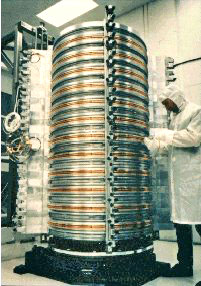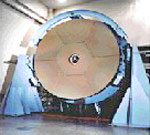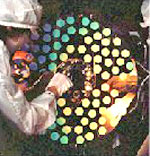|

from
FAS - FederationOfAmericanScientists Website
The potential to intercept and destroy a missile over enemy
territory soon after launch, rather than over friendly territory,
makes the development of a boost phase intercept (BPI) capability
very desirable. In concert with ground based theater missile defense
(TMD) systems already under development, the U.S. continues to
investigate BPI concepts for BMD systems.
The SBL program could develop the technology to provide the U.S.
with an advanced BMD system for both theater and national missile
defense. BMDO believes that an SBL system has the potential to make
other contributions to U.S. security and world security as a whole,
such as inducing potential aggressors to abandon ballistic missile
programs by rendering them useless.
Failing that, BMDO believes that
the creation of such a universal defense system would provide the
impetus for other nations to expand their security agreements with
the United States, bringing them under a U. S. sponsored missile
defense umbrella.
An SBL platform would achieve missile interception by focusing and
maintaining a high powered laser on a target until it achieves
catastrophic destruction.
Energy for the sustained laser burst is
generated by the chemical reaction of the hydrogen fluoride (HF)
molecule. The HF molecules are created in an excited state from
which the subsequent optical energy is drawn by an optical resonator
surrounding the gain generator.
Lasers have been studied for their usefulness in air defense since
1973, when the Mid Infrared Advanced Chemical Laser (MIRACL) was
first tested against tactical missiles and drone aircraft.
Work on
such systems continued through the 1980s, with the Airborne Laser
Laboratory, which completed the first test laser intercepts above
the earth. Initial work on laser based defense systems was overseen
by the Defense Advanced Research Projects Agency (DARPA), but
transferred to the newly created Strategic Defense Initiative
Organization (SDIO) in 1984. Work continues today under the auspices
of the BMDO, the successor to the SDIO.
The SBL program builds on a broad variety of technologies developed
by the SDIO in the 1980s.
The work on the Large Optics Demonstration
Experiment (LODE), completed in 1987, provided the means to control
the beams of large, high powered lasers. The Large Advanced Mirror
Program (LAMP) designed and built a 4 meter diameter space designed
mirror with the required optical figure and surface quality.
In
1991, the Alpha laser (2.8 mm) developed by the SDIO achieved
megawatt power at the requisite operating level in a low pressure
environment similar to space. Numerous Acquisition, Tracking, and
Pointing/ Fire Control (ATP/ FC) experiments both completed and
currently underway will provide the SBL platform with stable
aimpoints.
Successes in the field of ATP include advances in
inertial reference, vibration isolation, and rapid retargeting/
precision pointing (R2P2). In 1995 the Space Pointing Integrated
Controls Experiment offered near weapons level results during
testing.
Most recently, the Alpha LAMP Integration (ALI) program has
performed integrated high energy ground testing of the laser and
beam expander to demonstrate the critical system elements. The next
step is an integrated space vehicle ground test with a space
demonstration to conclusively prove the feasibility of deploying an
operational SBL system.
Future plans include orbiting the SBL Readiness Demonstrator (SBLRD)
in order to test all of the systems together in their intended
working environment.
Designs for the SBLRD satellite call for four
major subsystems:
-
the ATP system; providing acquisition, tracking,
targeting, stabilization, and assessment capabilities
-
the laser
device, providing the optical power, and beam quality, as well as
maintains nozzle efficiency
-
the optics and beam control systems,
enhancing and focus the beam, augmenting the capabilities of the
laser device
-
the space systems, providing a
stable platform, storage of the reactants, and furnish
electrical power (but do not power the laser)
The SBLRD is intended to demonstrate the capability to perform boost
phase Theater Missile Defense from space.
The objectives of the
space demonstration include gaining performance information critical
to the development of an operational SBL system, as well as gain a
general understanding of operating such a system.
BMDO and the Air Force agreed to transfer the execution of the SBLRD
project and the related SBL technology developments to the Air
Force. BMDO retained overarching SBL architecture responsibilities.
 Alpha High Energy Laser (HEL) Alpha High Energy Laser (HEL)
Megawatt class power levels were first achieved by the Mid-Infrared
Advanced Chemical Laser (MIRACL) originally sponsored by the Navy,
later by DARPA, and then by BMDO.
Because the design was intended
for sea level operation, the MIRACL laser does not achieve the
optimum efficiency necessary for space-based operation.
DARPA
launched the Alpha laser program, with the goal of developing a
megawatt level SBL that was scaleable to more powerful weapon levels
and optimized for space operation.
In this design, stacked
cylindrical rings of nozzles are used for reactant mixing. The gain
generation assembly achieves higher power by simply stacking more
rings. In 1991, the Alpha laser demonstrated megawatt class power
levels similar to MIRACL, but in a low pressure, space operation
environment.
Alpha demonstrates that multi-megawatt,
space-compatible lasers can be built and operated.
Large Advanced Mirror Program (LAMP)
To demonstrate the ability to fabricate the large mirror required by
an SBL, the Large Advanced Mirror Program (LAMP) built a
lightweight, segmented 4 m diameter mirror on which testing was
completed in 1989.
Tests verified that the surface optical
 figure
and quality desired were achieved, and that the mirror was
controlled to the required tolerances by adaptive optics
adjustments. figure
and quality desired were achieved, and that the mirror was
controlled to the required tolerances by adaptive optics
adjustments.
This mirror consists of a 17 mm thick face-sheet bonded
to fine figure actuators that are mounted on a graphite epoxy
supported reaction structure.
To this day, this is the largest
mirror completed for use in space. This LAMP segmented design is
applicable to 10 m class mirrors, and the Large Optical Segment
(LOS) program has since produced a mirror segment sized for an 11 m
mirror.
The large dimension of this LOS mirror segment approximates
the diameter of the LAMP mirror
 Beam Control- Large Optics Demonstration Experiment (LODE) and ALI Beam Control- Large Optics Demonstration Experiment (LODE) and ALI
The ability to control a beam was demonstrated at low power under
the Large Optics Demonstration Experiment (LODE) in 1987.
The
current high power beam control technology is now being integrated
with the Alpha laser and the LAMP mirror in a high power ground
demonstration of the entire high energy laser weapon element.
This
is known as the Alpha-LAMP Integration (ALI) program.
Acquisition, Tracking, Pointing (ATP)
The ATP technologies required (sensors, optics, processors, etc.)
have been validated through a series of component and integrated
testing programs over the last decade.
In 1985, the Talon Gold brassboard operated sub-scale versions of all the elements needed in
the operational ATP system including separate pointing and tracking
apertures, an illuminator, an inertial
 reference gyro system, fire
control mode logic, sensors and trackers. Talon Gold achieved
performance levels equivalent to that needed for the SBL. reference gyro system, fire
control mode logic, sensors and trackers. Talon Gold achieved
performance levels equivalent to that needed for the SBL.
In 1991,
the space-borne Relay Mirror Experiment (RME), relayed a low-power
laser beam from a ground site to low-earth orbit and back down to a
scoring target board at another location with greater pointing
accuracy and beam stability than needed by SBL.
The technology to
point and control the large space structures of the SBL was
validated in 1993 by the Rapid Retargeting and Precision Pointing
(R2P2) program that used a hardware test bed to develop and test the
large and small angle spacecraft slewing control laws and
algorithms.
The Space Pointing Integrated Controls Experiment
(SPICE) demonstrated in 1995 near weapon scale disturbance isolation
of 60-80 db and a pointing jitter reduction of 75:1.
In 1998, the
Phillips-Laboratory-executed High Altitude Balloon Experiment,
(HABE) will demonstrate autonomous end-to-end operation of the key
ATP-Fire Control (FC) functions in a realistic timeline against
actual thrusting ballistic missiles.
HABE will use a visible
low-power marker beam as a surrogate to the megawatt HF beam and
measure beam pointing accuracy, jitter and drift against a fixed
aimpoint on the target.
Current SBL planning is based on a 20 satellite constellation,
operating at a 40° inclination, intended to provide the optimum TMD
threat negation capability. At this degree of deployment, kill times
per missile will range from 1 to 10 seconds, depending on the range
from the missile.
Retargeting times are calculated at as low as 0.5
seconds for new targets requiring small angle changes. It is
estimated that a constellation consisting of only 12 satellites can
negate 94% of all missile threats in most theater threat scenarios.
Thus a system consisting of 20 satellites is expected by BMDO to
provide nearly full threat negation.
SBLRD Characteristics
-
Weight: 17,500 kg Length: 20.12 m
-
Diameter: 4.57 m Mirror Diameter: 4.0 m
-
Hydrogen fluoride chemical energy powered laser.
-
On board surveillance capabilities.
-
Super reflective mirror coatings allowing for uncooled optics.
-
Concurrent NMD / TMD capability.
Resources
-
Space-Based Laser Project Office - AF SMC
-
LASERS IN SPACE TECHNOLOGICAL OPTIONS FOR ENHANCING US MILITARY
CAPABILITIES by Mark E. Rogers, Lieutenant Colonel, USAF November
1997 Occasional Paper No. 2 Center for Strategy and Technology Air
War College Maxwell Air Force Base, Alabama
-
Lasers and Missile Defense: New Concepts for Space-based and
Ground-based Laser Weapons, William H. Possel, Lt Col, USAF -- CSAT
Occasional Paper No. 5 Center for Strategy and Technology Air War
College, July 1998
-
Laser Options for National Missile Defense Steven G. Leonard; Mark
L. Devirgilio (Faculty Advisor) Air Command and Staff College 1998 -
The Space Based Laser (SBL) can meet the NMD requirements. A 24 SBL
satellite constellation can kill 20 Taepo Dong 2 missiles launched
anywhere in the world at anytime. Each SBL satellite is projected by
BMDO to weigh 17,500 kilograms. Using the Aerospace Corporation’s
historical cost verses weight information, which shows that
satellites average cost is roughly $50,000 per pound, the first
satellite in this constellation would approach $2 billion dollars.
-
SPACE BASED LASER INTEGRATED FLIGHT EXPERIMENT The U.S. Air Force
contracted with an industry joint venture on February 08, 1999 for
the Space Based Laser Integrated Flight Experiment (SBL IFX). The
award constitutes the first increment of a Cost Plus Award Fee/Cost
Plus Fixed Fee contract valued at approximately $2-3 billion once
completed.
-
Space Based Laser Readiness Demonstrator Acquisition Approach Space
and Missile Systems Center Advanced Systems Directorate -- 01
September 1998
-
MEMORANDUM FOR ALL POTENTIAL OFFERORS
10 Jul 98
-
Draft Request for Proposal 10
Jul 98
-
STATEMENT OF OBJECTIVES DRAFT
-
10 Jul 98
-
SBL Glossary of Terms 10 July
1998
-
INFORMATION PROTECTION GUIDE [DRAFT]
10 July 1998
-
SECURITY GUIDANCE 10 July 1998
-
Interest in "Other than Prime" for the
SBLRD Contract(17 Jun 98)
-
DRAFT STATEMENT OF OBJECTIVES 9
June 1998
-
Interim Request for Proposal Release
15 Jun 98
-
Teaming within Space Based Laser (SBL)
Project Competition 9 Feb 98
-
STATEMENT OF OBJECTIVES (23 Jan
98)
-
DRAFT TECHNICAL REQUIREMENTS DOCUMENT
(TRD) 23 January 1998
-
Answers to Questions Submitted at Industry
Day- 26 Aug 97 (11 Sep 97)
-
SBL Technologies Request for Information
11 Sep 97
-
SBL Technologies Request for Information
11 Aug 1997
-
SBL Technologies Request for Information
29 July 1997
|

 Alpha High Energy Laser (HEL)
Alpha High Energy Laser (HEL) figure
and quality desired were achieved, and that the mirror was
controlled to the required tolerances by adaptive optics
adjustments.
figure
and quality desired were achieved, and that the mirror was
controlled to the required tolerances by adaptive optics
adjustments.  Beam Control- Large Optics Demonstration Experiment (LODE) and ALI
Beam Control- Large Optics Demonstration Experiment (LODE) and ALI reference gyro system, fire
control mode logic, sensors and trackers. Talon Gold achieved
performance levels equivalent to that needed for the SBL.
reference gyro system, fire
control mode logic, sensors and trackers. Talon Gold achieved
performance levels equivalent to that needed for the SBL. 















